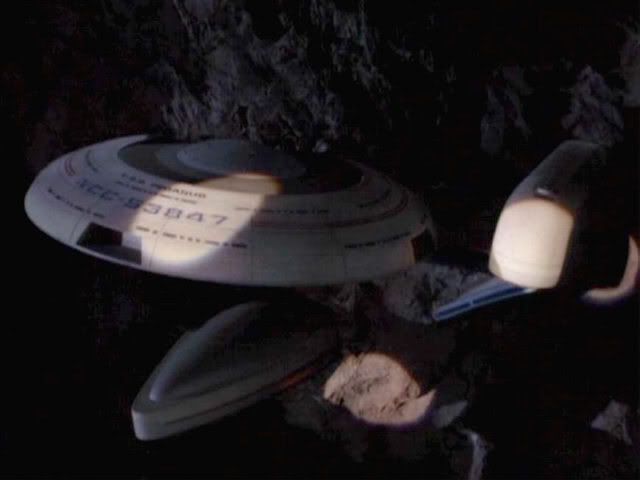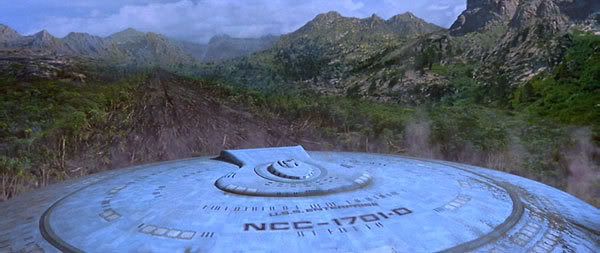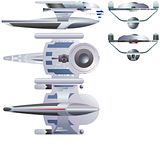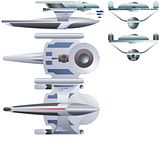But with artificial gravity, one could do much more practical things as well. Such as slides that go down both ways.
I love this idea! Why bother having ladders or stairs when you can have one slide down and another slide "up" the pylons?
-
Welcome! The TrekBBS is the number one place to chat about Star Trek with like-minded fans.
If you are not already a member then please register an account and join in the discussion!
You are using an out of date browser. It may not display this or other websites correctly.
You should upgrade or use an alternative browser.
You should upgrade or use an alternative browser.
accurate Oberth-Class schematics
- Thread starter Reverend
- Start date
How so?
Even the slimmest interpretations of the pylons seem to be at least two meter wide, which is plenty for a personnel elevator. And I don't see any real corners there that a 2 m x 2 m x 1 m rectangular cabin couldn't negotiate.
And the direction of down would be meaningless with artificial gravity. For all we know, the decks on the pod are laid at right angles wrt the decks in the saucer, which already requires the lift to rotate through 90 degrees.
But with artificial gravity, one could do much more practical things as well. Such as slides that go down both ways.
Timo Saloniemi
Well we've seen an MSD and a wreck with exposed decks, so we know all the decks are aligned the same way.
As for the pylons, the exterior dimensions may be JUST enough to fit a turbo car, but I don't think there's any room for the actual SHAFT and support equipment. Even if their was sufficient interior space (which I doubt), the car would have to effectively roll onto it's back to get through the corners, which while not impossible is a bit impractical for a ship this small. Besides, if you're stationed on a ship that small for any period of time I think you'd welcome a bit a physical exertion and take it from someone who used to build passenger lifts for a living, that's not a difficult climb if you're in reasonably good physical shape. I used to have to climb/ up and down up five story buildings dozens of times a day (because, guess what? the lift hadn't been installed yet!) and it's really not that hard. Hard is having to climb to the top of the building with a 20m drop block and tackle, first thing on a Monday morning.

I actually meant the technology and the price of the componentsthe Oberth is a very small ship which has been build in large numbers so that would mean they would skimp on anything even remotely fancy, why install a hardwired transporter system when a simple lift would suffice?
I assume this goes for the rest of the ship as well except the sensors and other things required to do science.
Seriously? Transporters are standard equipment and having them hard linked is just a matter of running a conduit between the two pattern buffers. As for the "expense" money doesn't exist in this context and I doubt a few hundred meters of conduit and trunking would be an unreasonable use of resources.
That actually looks pretty nice so far. One thing, though: I think your lighting source on the saucer section in your dorsal view is wrong. It makes it look convex. It's easiest to see looking at your posted thumbnail. Oh, and the part aft of the saucer section is supposed to be flat.
Now, what do you think about the opinion stated at Ex Astris Scientia about the overall length?
Don't worry too much about the colouring, at this point I'm more focused on getting the proportions right than polishing the chrome.
As for the length, I'm provisionally trusting Bernd's assertion that it's probably around the 150m mark. However, some detailing on the TNG version (like the docking port) leads be to believe the effects people later decided it should be around 200m. I think the official length from ST:III was about 130m but I'm pretty much undecided as there's lots of problems with all three sizes. Perhaps the 24th century Oberths were scaled up, who knows. Either way it's something best left until after the exteriors are sorted out.
I like the Oberth.
It gets a bad rap, but it's a nice looking ship.
It gets a bad rap, but it's a nice looking ship.
I just noticed something weird about the Oberth class. I was looking at the picture of the U.S.S Pegasus at Ex Astris Scientia, where you can see the escape pods, shown below.
And here's a view of escape pods on a ship of known length viewed from almost the same kind of angle, which should allow one to estimate the overall length of the Oberth class with fair accuracy with one image resized to match size of the pods in the two images. But look at how small the escape pods are on the Pegasus in relation to the saucer, in comparison with those in the Ent-D. The same goes for the Windows, making the Pegasus huge, not 120 or 150 meters but . . . wft!


And here's a view of escape pods on a ship of known length viewed from almost the same kind of angle, which should allow one to estimate the overall length of the Oberth class with fair accuracy with one image resized to match size of the pods in the two images. But look at how small the escape pods are on the Pegasus in relation to the saucer, in comparison with those in the Ent-D. The same goes for the Windows, making the Pegasus huge, not 120 or 150 meters but . . . wft!


^^^
Yeah, what escape pods?
Yeah, what escape pods?
Okay, sorry. If they're at the top of the saucer, they should be between groups of windows. I don't see them. Memory alpha says there's a minimum complement of two pods and cites references.
Anyway the windows look too small for the ship's size.
Here are some nice Oberth pics (from meshes), and I don't see pods.
http://www.trekmania.net/the_fleet/utopia/fleet/oberth.htm
Anyway the windows look too small for the ship's size.
Here are some nice Oberth pics (from meshes), and I don't see pods.
http://www.trekmania.net/the_fleet/utopia/fleet/oberth.htm
Last edited:
The Oberth class might look better if the "saucer" was as streamlined and narrow as the lower hull section.
Okay, sorry. If they're at the top of the saucer, they should be between groups of windows. I don't see them. Memory alpha says there's a minimum complement of two pods and cites references.
Anyway the windows look too small for the ship's size.
Here are some nice Oberth pics (from meshes), and I don't see pods.
http://www.trekmania.net/the_fleet/utopia/fleet/oberth.htm
Memory Alpha was probably referencing the following lines from "Realm of Fear"...
GEORDI
Maybe they abandoned ship.
WORF
Unlikely. Both escape pods are
still on board.
PICARD
I remember reading about it. The
ship was destroyed by a... warp
core breach as I recall.
RIKER
That's right. The Captain and I,
along with seven others managed to
get to an escape pod before the
breach became critical.
All that tells us is that the Pegasus had at least one pod (presumably within running distance of the bridge) and that the Yosemite only had two, which is fair given that ship only had a crew of five.
As for the pod placements, the way I'm looking at it is that all of those blue and dark grey panels either lift up or retract to allow access to the interior modular sections, so an escape pod could be behind any one of them. However, I'm thinking the most likely place would be those dark sections around the dorsal dome (which may or may not be the bridge) since it's closest to where most of the crew are likely to be.
Since it's a modular arrangement, in cases where the ship is outfitted for a smaller crew, the unneeded pods are removed and other types of equipment modules are installed in their place.
Maybe they abandoned ship.
WORF
Unlikely. Both escape pods are
still on board.
and "The Pegasus".
PICARD
I remember reading about it. The
ship was destroyed by a... warp
core breach as I recall.
RIKER
That's right. The Captain and I,
along with seven others managed to
get to an escape pod before the
breach became critical.
All that tells us is that the Pegasus had at least one pod (presumably within running distance of the bridge) and that the Yosemite only had two, which is fair given that ship only had a crew of five.
As for the pod placements, the way I'm looking at it is that all of those blue and dark grey panels either lift up or retract to allow access to the interior modular sections, so an escape pod could be behind any one of them. However, I'm thinking the most likely place would be those dark sections around the dorsal dome (which may or may not be the bridge) since it's closest to where most of the crew are likely to be.
Since it's a modular arrangement, in cases where the ship is outfitted for a smaller crew, the unneeded pods are removed and other types of equipment modules are installed in their place.
All right, then, another way to measure the overall length of this thing is by comparing the distance from the top of the row of windows in front above the forward shuttlebay doors against overall length.
I make that distance as 5 meters, assuming 3-meter deck height, comfortable viewing height, and hull thickness on the underside of the saucer. It's just an estimate.
1080 * (5/30) = 180 meters overall length
That's measuring the side view at Ex Astris Scientia (in pixels).
5.0 m -> 180.0 m
4.9 m -> 176.4 m
4.8 m -> 172.8 m
4.7 m -> 169.2 m
I make that distance as 5 meters, assuming 3-meter deck height, comfortable viewing height, and hull thickness on the underside of the saucer. It's just an estimate.
1080 * (5/30) = 180 meters overall length
That's measuring the side view at Ex Astris Scientia (in pixels).
5.0 m -> 180.0 m
4.9 m -> 176.4 m
4.8 m -> 172.8 m
4.7 m -> 169.2 m
To be sure, we don't know if any of the surface features on the ship are actually windows. The Morse code patterns on the saucer seem more akin to the sensor strips of TNG era vessels anyway.
Since the rows don't match either the exposed decks of the Vico model or the decks in the cutaway drawing of that ship, and since we never see any windows aboard an Oberth anyway, I'd hesitate to use the rows for measuring anything.
Timo Saloniemi
Since the rows don't match either the exposed decks of the Vico model or the decks in the cutaway drawing of that ship, and since we never see any windows aboard an Oberth anyway, I'd hesitate to use the rows for measuring anything.
Timo Saloniemi
There's also the possibility that the windows (if that's what they are) are extremely small and run along the upper angled face of the corridors that run the circumference of the saucer.
I think it's safe to say that the model builder wasn't told how big the ship is supposed to be, or nobody had determined an exact length, or it was meant to be much bigger than we generally think.
See Bernd's article here for a more complete look at the various scale issues.
Anyway, here's the latest.

I think it's safe to say that the model builder wasn't told how big the ship is supposed to be, or nobody had determined an exact length, or it was meant to be much bigger than we generally think.
See Bernd's article here for a more complete look at the various scale issues.
Anyway, here's the latest.

I dunno, I've kind of always liked it. And I've liked the idea that the bulk of the livable decks are in the primary hull, with the secondary hull being a modular unit that could be swapped out. That would give the fleet a significant amount of versatility with the basic design.
Okay, your latest set of drawings looks good, and I downloaded it and did some measurements. First, at a glance, your shuttles look too big to fit through the shuttlebay doors, which you seem to have drawn correctly.
Your side view has overall length of the ship of 1485 pixels and clearance of the shuttlebay doors of 23 pixels in height. So the absolute minimum clearance of 12 feet (3.66 meters) would give the ship an overall length of 236.25 meters (1485 * .1591m). The more comfortable clearance of 4.7 meters puts overall length at 303.38 meters (1485 *.2043m).
Shuttlebay doors:
(23 * .1591 = 3.659)
(23 * .2043 = 4.689)
Your side view has overall length of the ship of 1485 pixels and clearance of the shuttlebay doors of 23 pixels in height. So the absolute minimum clearance of 12 feet (3.66 meters) would give the ship an overall length of 236.25 meters (1485 * .1591m). The more comfortable clearance of 4.7 meters puts overall length at 303.38 meters (1485 *.2043m).
Shuttlebay doors:
(23 * .1591 = 3.659)
(23 * .2043 = 4.689)
Last edited:
I dunno, I've kind of always liked it. And I've liked the idea that the bulk of the livable decks are in the primary hull, with the secondary hull being a modular unit that could be swapped out. That would give the fleet a significant amount of versatility with the basic design.
That was, and is for the most part, the way I take the design: The lower pod is just a module that can swapped out for mission specific needs. The Vico throws a bit of a wrench into the works, but not by much; seeing as it is supposedly a civilian ship, it might be carrying a "general purpose" pod or some such.
I've also trended toward thinking that the Pod isn't meant to be manned by a nominal crew rotation. What I mean is, it might be a thing where a science-team bunks down in it for several days or weeks at a time running experiments and scans, while the regular crew is topside in the saucer-section.
Agreed. That solves the whole issue for me of having to run turbolifts or a transporter beam to that lower section. Most of the fanon Oberth variants I've seen have basically had a swapped lower pod, and that makes sense. It's not hard to imagine that Starfleet would be able to build a lot more of these small hulls than the heavier vessels.
I've also trended toward thinking that the Pod isn't meant to be manned by a nominal crew rotation. What I mean is, it might be a thing where a science-team bunks down in it for several days or weeks at a time running experiments and scans, while the regular crew is topside in the saucer-section.
I've considered that idea before as well. I've even wondered whether there might often be a civilian science group down below conducting Federation sponsored research projects...along the lines of Carol Marcus' team...with a Starfleet crew above to handle ship duties.
Maybe sort of like the Space Shuttle program where a regular NASA flight crew command and fly the shuttle, while (usually) civilian personnel function as mission and payload specialists on a non-permanent basis?
If the secondary hull is indeed modular in design, then dedicated mission/payload experts might make sense, and they would probably prefer to stay close to their work anyway.
When there are personnel down there that is. I also have always felt that the secondary hull was probably one large unmanned sensor package, and probably didn't require routine visits from the crew anymore than the Miranda/Avenger class weapons pod.
Mark
Similar threads
- Replies
- 1
- Views
- 231
- Replies
- 9
- Views
- 822
- Replies
- 1
- Views
- 5K
- Replies
- 5
- Views
- 2K
If you are not already a member then please register an account and join in the discussion!


 You are doing a fine job.
You are doing a fine job.